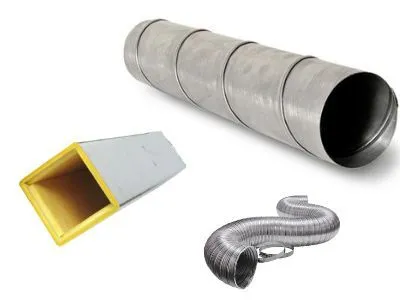
Main Types of Air Ducts: Navigating the Labyrinth of Heating and Cooling
In the intricate maze of your home’s infrastructure, there lies a network unseen yet vital: the air duct system. These silent arteries transport conditioned air, maintaining your comfort and health. But just like veins vary in their functions, so too do different types of air ducts cater to specific needs. Unraveling the secrets of these conduits equips you to make informed decisions for your home’s HVAC system.
Defining the Types: Flexibility vs. Rigidity
The first major bifurcation in the ductwork world lies in its rigidity. We encounter:
- Flexible Ductwork: As the name suggests, these ducts bend and weave through tight spaces or around obstacles. Constructed with a metal wire helix encased in insulated plastic, they’re lightweight and easy to install. However, their flexible nature comes at a cost. Friction within the ductwork reduces airflow efficiency, and their porousness makes them susceptible to dust and mold accumulation.
- Rigid Ductwork: Think sturdy, unyielding channels. Made from sheet metal (galvanized steel or aluminum) or fiberglass-reinforced plastic, these ducts offer superior airflow due to their smooth surfaces. They’re also more durable and easier to clean, minimizing dust and mold concerns. The downside? Rigid ducts require meticulous planning and installation, often involving cutting through walls or ceilings.
What Are The Three Main Types Of Hot Water Systems?
Delving Deeper: Material Matters
Within each rigidity category, material variations offer further nuance:
- Sheet Metal Ducts: The gold standard for durability and efficiency, sheet metal ducts excel in residential and commercial applications. Their smooth surfaces minimize friction and resist mold growth. However, their installation complexity and cost can be considerable.
- Fiberglass-Lined Ducts: Combining the strength of sheet metal with the sound-dampening properties of fiberglass insulation, these ducts offer a quieter operation. However, the insulation can harbor dust and moisture, necessitating thorough cleaning and potential mold remediation.
- Fiberboard Ducts: Composed of compressed wood fibers laminated with a moisture barrier, fiberboard ducts are an affordable option. However, their rough interior surfaces create airflow friction, and their susceptibility to moisture makes them prone to mold growth.
Shape Matters: Round vs. Rectangular
Beyond material, the cross-section shape plays a crucial role:
- Round Ducts: Champions of airflow efficiency, round ducts minimize friction due to their lack of corners. They’re also easier to manufacture and install, making them a cost-effective choice. However, they may not fit seamlessly into tight spaces or utilize available space as effectively as rectangular ducts.
- Rectangular Ducts: These flat, box-shaped ducts offer space optimization, fitting snugly against walls and ceilings. They also provide more design flexibility for accommodating specific airflow requirements. However, their sharp corners create friction, impacting efficiency, and their installation can be more complex than round ducts.
Choosing the Right Ducts: A Balancing Act
Selecting the ideal air ducts hinges on several factors:
- Budget: Rigid metal ducts offer long-term value but have a higher upfront cost. Flexible ducts are cheaper but less efficient and durable.
- Space Constraints: For tight spaces and hard-to-reach areas, flexible ducts reign supreme. Rigid ducts require precise planning and may necessitate modifications to walls and ceilings.
- Noise Considerations: Fiberglass-lined ducts dampen noise, ideal for bedrooms or media rooms. Sheet metal ducts generate minimal noise when properly installed and maintained.
- Airflow Efficiency: Sheet metal and round ducts minimize friction, maximizing airflow and system performance. Flexible and rectangular ducts may require larger diameters or higher fan speeds to compensate for efficiency losses.
- Maintenance Needs: Smooth surfaces like sheet metal are easier to clean and less prone to harboring dust and mold. Fiberglass-lined and fiberboard ducts require regular cleaning and may necessitate mold remediation if neglected.
Beyond the Basics: Additional Considerations
Remember, your air duct system is a part of a larger ecosystem. Here are some additional factors to ponder:
- HVAC System Type: Consider the compatibility of your chosen ductwork with your heating and cooling system. Certain systems, like forced air furnaces, have specific requirements for ductwork sizing and material.
- Local Building Codes: Consult local building codes to ensure your chosen ductwork meets safety and performance standards.
- Professional Installation: While some flexible ductwork may be DIY-friendly, complex systems or rigid ductwork should be installed by qualified professionals to ensure optimal performance and safety.
Conclusion: Unlocking the Ductwork Secrets
Understanding the nuances of air duct types empowers you to make informed decisions for your home’s comfort and safety. From navigating tight spaces to maximizing airflow efficiency, choosing the right ducts ensures your HVAC system operates at its peak, keeping you cool in summer and warm in winter. So, venture forth, explorer, and demystify the labyrinth of air ducts – your home’s climate




